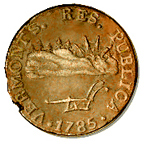woodpusher:
"One can believe your buillcrap or the linked, cited, and quoted unanimous Opinion of the United States Supreme Court in Vermont v. New Hampshire, 289 U.S. 593 (1933).
They clearly opined that Vermont was admitted as a free, sovereign, and independent state with self-appointed borders." That Vermont was considered a state in 1791, like Massachusetts or New York, is one thing, not here disputed, and not needing a SCOTUS decision to verify, so far as I can tell.
But your words like, "free, sovereign and independent" are not found in any of the documentation you've posted here.
Nor is the term "Republic of Vermont" ever mentioned legally.
That means the so-called "Republic of Vermont", was never equivalent to, for example, the actual Republic of Texas.
Nor was Vermont ever formally recognized as a country, unlike Texas which signed treaties and exchanged ambassadors, Vermont did none of those things.
Such independence as Vermont did achieve came from agreements by Massachusetts, Connecticut and New York, for purposes of admitting Vermont as a state.
By normal standards of what makes a legitimate country, Vermont never was.
In that, the so-called "Republic of Vermont" was more similar to the Confederacy than it was to, for example, the Republic of Texas. ![]()
They clearly opined that Vermont was admitted as a free, sovereign, and independent state with self-appointed borders.
That Vermont was considered a state in 1791, like Massachusetts or New York, is one thing, not here disputed, and not needing a SCOTUS decision to verify, so far as I can tell.
But your words like, "free, sovereign and independent" are not found in any of the documentation you've posted here.
That Vermont was a State in 1777 is not disputed. It was confirmed by a United States Supreme Court Opinion.
It appears you didn't look.
In determining the boundary, the Court considers the history of the subject from the creation of New York and New Hampshire as adjoining Royal Provinces to the admission of Vermont into the Union as an independent state. Vermont's claim of a boundary at the thread of the channel was based upon the following propositions: township grants made by the Governor of the Province of New Hampshire, by royal authority, between 1741 and 1764, on the west side of the Connecticut River in the territory now Vermont, were bounded by the river, which was nontidal, and carried title to its thread by virtue of the common law of England; an order of the King-in-Council of July 20, 1764, fixing the boundary between the Provinces of New York and New Hampshire at the "western banks of the River Connecticut," thus including the territory now Vermont in the Province of New York, was nullified by the successful revolution of the inhabitants of the New Hampshire grants; hence the eastern boundary of the revolutionary State of Vermont was the same as the eastern limits of the township grants -- namely, the thread of the river; Vermont was admitted to the Union as a sovereign independent state with her boundaries those established by her revolution. Her eastern boundary was therefore the thread of the Connecticut River.
The Special Master sustained all these contentions except the last one. With respect to it, he found that Vermont had, by resolution of her Legislature of February 22, 1782, relinquished any claim to jurisdiction east of the west side of the river at low water mark, in conformity to a Congressional resolution of August 20, 21, 1781, prescribing terms upon which Congress would consider the admission of Vermont to the Union.
- - - - -
In view of these facts, the Special Master concluded that the Order-in-Council was nullified by successful revolution, and Vermont was admitted as an independent state with self-constituted boundaries.
- - - - -
her independence was recognized by New Hampshire in 1777, by Massachusetts in 1781, and by New York in 1790
- - - - -
If admitted as a free and independent state her boundaries were those fixed by her own declaration of independence as limited by her acceptance of the conditions of the Congressional resolution of August 20, 21, 1781. That boundary we conclude was also one carrying to the river and to low-water mark.
At 619-620:
We conclude that the true boundary is at the low-water mark on the western side of the Connecticut River, as the special master has found.
Such independence as Vermont did achieve came from agreements by Massachusetts, Connecticut and New York
Utter nonsense. Vermont independence does not date from recognition by MA, CT(?), NY any more than American independence dates to the British Recognition in the Paris Peace Treaty. The United States does not celebrate independence day on September 3, 1783. Vermont waged successful revolution and their independence dates back to their Declaration of Independence in 1777.
That means the so-called "Republic of Vermont", was never equivalent to, for example, the actual Republic of Texas.
The Republic of Vermont was independent a great deal longer than the Republic of Texas. Texas claim to fame was recognition by three countries in the world.
ia.org/wiki/Haldimand_Affair
From your sole and unimpeachable source.
"The Haldimand Affair (also called the Haldimand or Vermont Negotiations) was a series of negotiations conducted in the early 1780s (late in the American Revolutionary War) between Frederick Haldimand, the British governor of the Province of Quebec, his agents, and several people representing independent Vermont Republic
The Republic of Vermont has its own military, its own postal service, and even coined its own money.

